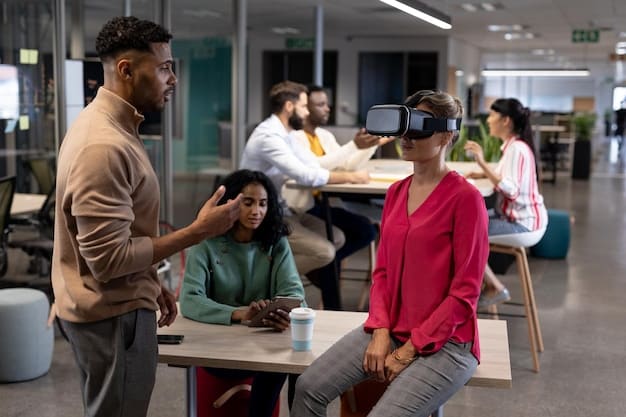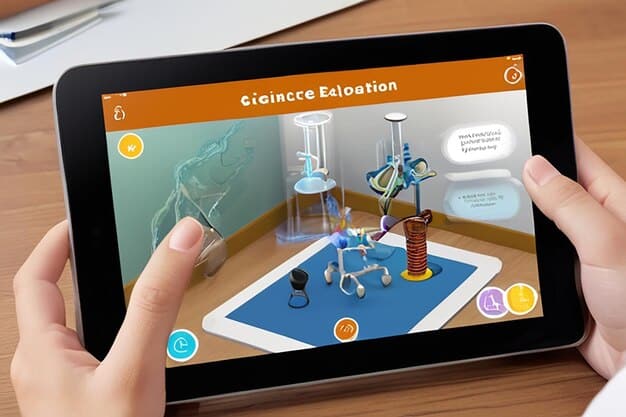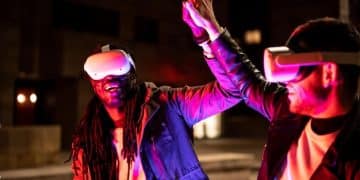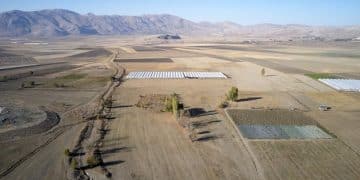Virtual and Augmented Reality in US Education: Latest Trends

Virtual reality (VR) and augmented reality (AR) are transforming US education and training by providing immersive, interactive learning experiences that enhance engagement and knowledge retention for students and professionals alike.
The landscape of education and training in the United States is undergoing a significant transformation, thanks to the innovative applications of virtual reality (VR) and augmented reality (AR). These technologies are offering immersive, interactive learning experiences that promise to reshape how students and professionals acquire knowledge and skills.
The Rise of VR and AR in Education
Virtual reality (VR) and augmented reality (AR) are rapidly emerging as powerful tools in the education sector. Their ability to create immersive and interactive learning environments is capturing the attention of educators and students alike.
But how exactly are these technologies being integrated, and what impact are they having on the learning experience?
What are VR and AR?
VR creates a completely digital environment that users can interact with, typically through headsets and controllers. AR, on the other hand, overlays digital information onto the real world, often through smartphones or tablets.
- VR in Education: Offers fully immersive experiences, such as virtual field trips to historical sites.
- AR in Education: Enhances real-world learning by adding digital layers, like interactive textbooks.
- Combined Applications: Some programs use both VR and AR to create hybrid learning environments.
Both technologies offer unique opportunities to enhance learning and engagement.

Benefits of VR and AR in Education
The adoption of VR and AR in education is driven by the numerous benefits these technologies offer, from increased engagement to improved knowledge retention.
Let’s delve into the specific advantages that VR and AR bring to the educational landscape.
Enhanced Engagement and Motivation
One of the primary benefits of VR and AR is their ability to capture and maintain students’ attention. The immersive and interactive nature of these technologies transforms learning from a passive activity into an engaging experience.
This can lead to higher levels of motivation and a greater interest in the subject matter.
Improved Knowledge Retention
Studies have shown that students retain more information when they learn through immersive experiences. VR and AR provide opportunities for active learning, where students can interact with the material in a tangible way.
This active engagement helps solidify understanding and improve long-term retention.
Practical Applications in US Schools
Across the United States, schools are beginning to implement VR and AR technologies in various subjects and grade levels. These practical applications showcase the versatility and potential of these tools.
From virtual field trips to interactive science lessons, the possibilities are vast.
Virtual Field Trips
VR allows students to visit historical sites, museums, and even different countries without leaving the classroom. These virtual field trips provide a unique and memorable learning experience that can spark curiosity and broaden perspectives.
Interactive Science Lessons
AR can bring abstract scientific concepts to life by overlaying digital models onto real-world objects. Students can explore the structure of a cell or the solar system in an interactive and engaging way.
Special Education
VR and AR can be particularly beneficial for students with special needs. These technologies can provide personalized learning experiences tailored to individual abilities and learning styles.
This can help create a more inclusive and effective learning environment.

VR and AR in Corporate Training Programs
Beyond traditional education, VR and AR are making significant inroads into corporate training programs. These technologies offer cost-effective and efficient ways to train employees in various industries.
Let’s explore some key applications in the corporate world.
Safety Training
VR can simulate hazardous environments, allowing employees to practice safety procedures without real-world risks. This is particularly valuable in industries such as construction, manufacturing, and energy.
Product Training
AR can overlay digital information onto physical products, providing step-by-step instructions for assembly, maintenance, and repair. This can help employees quickly learn how to work with new products.
Soft Skills Training
VR can simulate realistic workplace scenarios, allowing employees to practice communication, teamwork, and leadership skills in a safe and controlled environment.
Challenges and Considerations
Despite the numerous benefits, there are also challenges and considerations associated with implementing VR and AR in education and training. These include cost, accessibility, and the need for effective teacher training.
Addressing these challenges is crucial for successful adoption.
Cost and Accessibility
VR and AR equipment can be expensive, which may limit access for schools and organizations with tight budgets. Finding affordable solutions and exploring funding opportunities are essential.
Teacher Training
Teachers need adequate training to effectively integrate VR and AR into their lessons. Professional development programs can help educators learn how to use these technologies to enhance learning outcomes.
Content Development
High-quality VR and AR content is essential for effective learning experiences. Investing in the development of engaging and educational content is crucial.
Future Trends in VR and AR Education
The future of VR and AR in education looks promising, with ongoing advancements in technology and increasing adoption rates. As these technologies continue to evolve, we can expect to see even more innovative applications in the classroom and training room.
Here are some key trends to watch.
- Increased Accessibility: As VR and AR technology becomes more affordable, it will become more accessible to schools and organizations.
- AI Integration: The integration of artificial intelligence (AI) will enable personalized learning experiences tailored to individual student needs.
- Collaboration: Collaborative VR and AR environments will allow students to work together on projects and solve problems in a virtual space.
These trends will shape the future of education and training in the United States.
| Key Point | Brief Description |
|---|---|
| 🚀 Immersive Learning | VR/AR offers immersive and interactive learning environments. |
| 🧠 Knowledge Retention | VR/AR improves knowledge retention through active engagement. |
| 🎓 Practical Applications | Includes virtual field trips and interactive science lessons. |
| 🏢 Corporate Training | VR/AR enhances safety and product training in corporations. |
Frequently Asked Questions
▼
VR creates a fully immersive digital environment, while AR overlays digital information onto the real world.
▼
VR provides immersive and interactive experiences that increase engagement and improve knowledge retention.
▼
AR is used for interactive science lessons, enhancing textbooks, and providing step-by-step instructions.
▼
VR can simulate hazardous environments for safety training and provide realistic workplace scenarios for soft skills training.
▼
The main challenges include cost, accessibility, the need for teacher training, and the development of high-quality content.
Conclusion
As virtual reality and augmented reality continue to evolve, their applications in US education and training hold immense potential. By addressing the challenges and embracing the opportunities, educators and organizations can leverage these technologies to create more engaging, effective, and accessible learning experiences for all.





